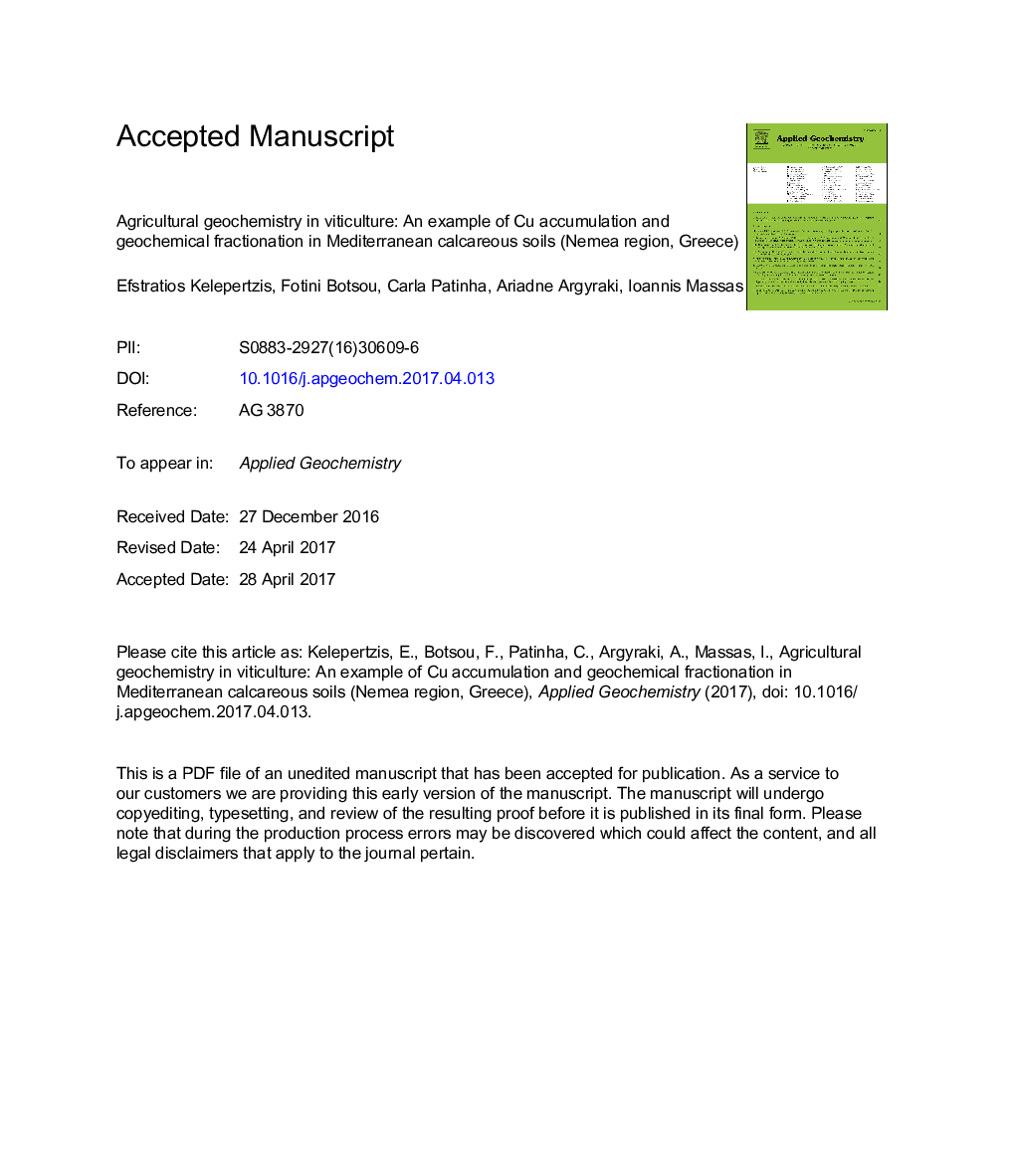| کد مقاله | کد نشریه | سال انتشار | مقاله انگلیسی | نسخه تمام متن |
|---|---|---|---|---|
| 8863245 | 1620204 | 2018 | 40 صفحه PDF | دانلود رایگان |
عنوان انگلیسی مقاله ISI
Agricultural geochemistry in viticulture: An example of Cu accumulation and geochemical fractionation in Mediterranean calcareous soils (Nemea region, Greece)
ترجمه فارسی عنوان
ژئوشیمی کشاورزی در کشت زراعی: یک نمونه از انباشت سی و تجزیه ژئوشیمیایی در خاک های آهکی مدیترانه (نا امیا، یونان)
دانلود مقاله + سفارش ترجمه
دانلود مقاله ISI انگلیسی
رایگان برای ایرانیان
کلمات کلیدی
موضوعات مرتبط
مهندسی و علوم پایه
علوم زمین و سیارات
ژئوشیمی و پترولوژی
چکیده انگلیسی
The Nemea region has been devoted to viticulture from historic times, and currently, is one of the most important wine-producing areas in Greece. In this study we report the extent of Cu and other element (As, Cd, Co, Cr, Mn, Ni, Pb, and Zn) enrichment, their geochemical partitioning into the soil components (evaluated by a seven-step sequential extraction procedure) and the plant availability of Cu (defined as the diethylene triamine pentaacetic acid, DTPA -extracted Cu). Major soil properties were also determined. Total Cu contents in the Nemea topsoil were in the range 33.1-291 mg kgâ1. Enrichment Factors (EF), calculated against uncultivated soils from the neighboring Argos region, showed that the Nemea topsoil was significantly enriched with Cu (median EF 5.9) and in a limited number of samples moderately enriched (median EFs: 2-5) with P, As, Cd and Mn. On average, 20% of total Cu was readily available for plant uptake. Application of principal component analysis (PCA) showed that natural Cu present in Nemea soil was principally associated with the residual and oxidizable fractions. On the other hand, anthropogenic related Cu was linked to acid soluble and reducible geochemical phases, exhibiting a strong affinity with the plant available Cu. Nickel and Cr were principally found in the residual fraction, supporting their origin from ophiolitic rocks; Manganese and Co were mostly associated with Mn oxides, Cd was found in labile fractions, whereas As, Pb and Zn were bound, more or less, to reducible and oxidizable substrates. Copper and P were the only elements that were found to decline at the 50 cm soil depth. Despite the decline with depth, Cu contents did not reach background levels. We did not find differences in Cu availability and partitioning between the surface and deep soil samples, inferring that Cu migrated to the soil profile by tillage practices. Finally, the comparison of the geochemical composition of vineyard soils with the nearby Argos citrus soils revealed the pronounced enrichment of the citrus soils with P, Zn and Cd due to intensive fertilizer applications. In contrast, the vineyard soils are more susceptible to Cu and As accumulation.
ناشر
Database: Elsevier - ScienceDirect (ساینس دایرکت)
Journal: Applied Geochemistry - Volume 88, Part A, January 2018, Pages 23-39
Journal: Applied Geochemistry - Volume 88, Part A, January 2018, Pages 23-39
نویسندگان
Efstratios Kelepertzis, Fotini Botsou, Carla Patinha, Ariadne Argyraki, Ioannis Massas,
